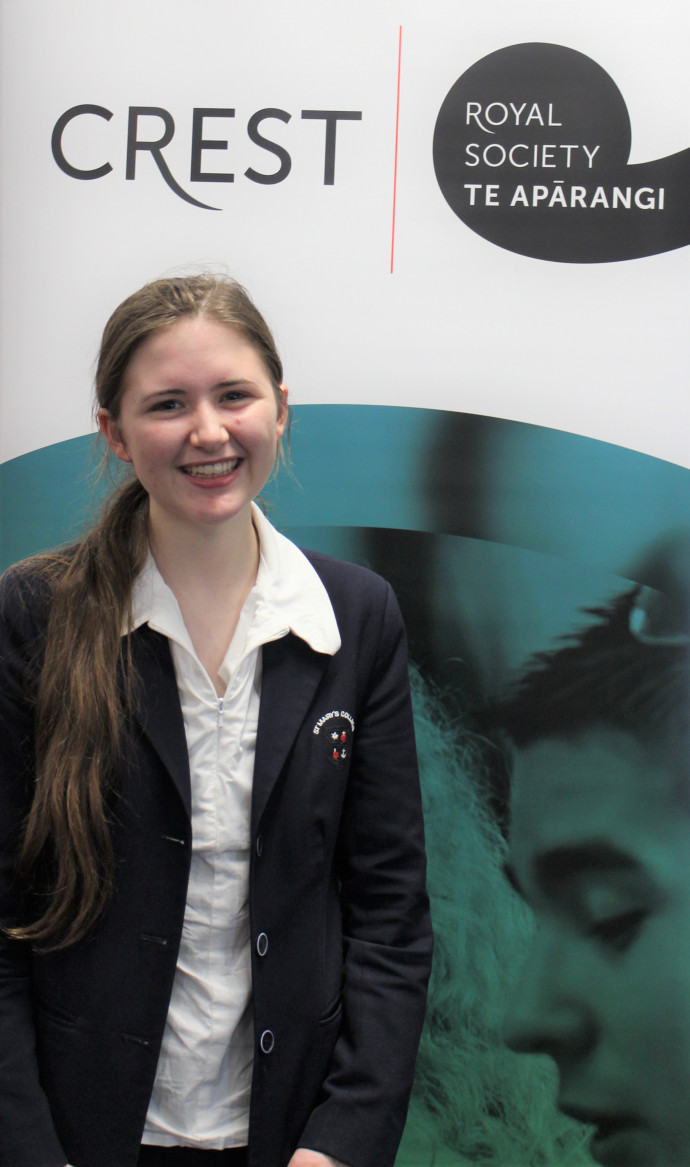2019 | Irisa Hudson

Irisa Hudson of St Mary’s College, Auckland, has been awarded a Gold CREST for her project “Of Moss and Mites. An investigation into the role of springtails in the fertilisation of two moss species“.
Mentors: Dr Anne C. Gaskett, University of Auckland and Emma Bodley, Auckland Botanic Gardens.
Supporter: Mr Asa Fowkes
Supervising teacher: Mr Keith Paterson
Gold CREST medal presented by: Dr Tom Baker, MRSNZ Councillor
Irisa’s Executive Summary states:
“The aim of this paper is to provide insight into the role that springtails play in the fertilisation of two species of New Zealand moss; Ptychomnion aciculare and Barbula calycina. These mosses are both commonly seen in urban and forested areas of New Zealand, and other countries such as Australia. This is in response to a huge gap in literature regarding moss reproduction. As well as the recent studies suggesting that, moss fertilisation is not vectored by water.
It has previously been accepted that the transfer of sperm produced from the antheridia (the male organ of the moss), to the egg contained in the archegonium (the female organ) and is controlled by the presence of a water film, for which the sperm to swim through. Recent studies such as those of Cronberg (2006) and Rosenstiel et al., (2012) have discovered that this mechanism may not be the case, and in fact microarthropods such as ortobid mites and springtails can act as vectors for sperm transfer. Other than these two recent studies, no other studies have been published in this field, and none in the southern hemisphere.
In order to determine the presence of springtails in both species of moss, portions of moss of each species were placed in a tulgrens funnel where the extracted arthropods counted, and the results recorded. In both moss species, springtails were found. However, there was a greater number of springtails gathered form Ptychomnion aciculare than from Barbula calycina. The next experiment undertaken was the fertilisation experiment in which patches of male and female mosses were placed in vessels at varying distances apart, containing water absorbing plaster- of -paris as a substrate. Into half of the vessels, springtails were added, the other half contained no water or springtails. Consistently across all Ptychomnion aciculare patches in vessels containing springtails, sporophytes were produced – an indication of successful sperm transfer. In vessels of the same species where no springtails were present, no sporophytes were produced. In the case of Barbula calycina, only one sporophyte was produced (in a vessel containing springtails) this sporophyte was very small. One explanation for this is the longer sporophyte growth time documented for Barbula calycina when compared to Ptychomnion aciculare.
Statistically there was a significant difference in sporophyte production between the two species of moss (Mann-Whitney U test, U = 425, p < 0.01). Ptychomnion aciculare produced sporophytes in most trials, whereas Barbula calycina produced only one sporophyte in one trial.
For Ptychomnion aciculare, the presence of springtails correlated with significantly increased sporophyte production (U = 144, p < 0.01). There was a trend for more sporophytes to be produced when the moss patches were placed closer together (see Figures 21 & 22) but this was not statistically significant (Kruskall-Wallis test, H = 0.906, p = 0.636).
These results point to a possible plant-pollinator relationship of springtails and Ptychomnion aciculare. Due to the age of both springtails and mosses (with springtails emerging around 400 million years ago, and moss around 300 million years ago) this could be the first instance of a relationship of this kind, pre-dating the first flowering plants (which are thought to date to around 140 million years ago). This situation would result in the moss-springtail relationship being the first known example of a plant-pollinator relationship. Subsequently, dates of moss evolution may require revision based on this work.
In future studies, it is recommended to use a greater number of species, spread over a greater geographical area, with repeating each of the fertilisation and Tulgren funnel experiments multiple times throughout the year. The methods of the fertilisation experiment could also be improved upon by using a more natural substrate and the observation period. Further investigations to identify a possible motive for the participation of springtails in gamete transfer, which would further solidify this putative plant- pollinator style relationship would be of great interest.”
